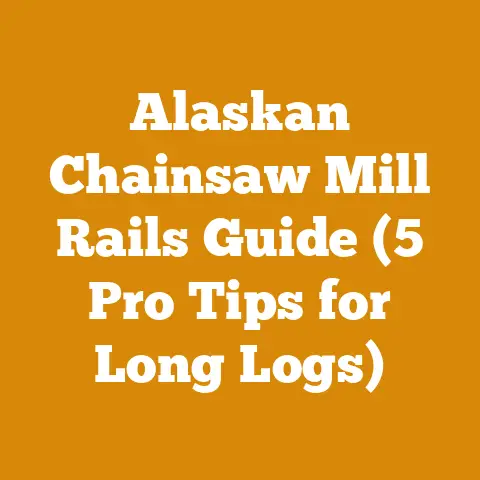When to Trim Crabapple Trees (Pro Tips for Neglected Tree Revival)
The scent of freshly cut wood, the rhythmic roar of a chainsaw, the satisfying crack of a log splitting – these are the sounds and smells that define my happy place. For years, I’ve lost myself in the art of wood processing and firewood preparation, transforming raw timber into something useful, something that provides warmth and comfort. It’s a craft that demands respect, patience, and a healthy dose of know-how. And just like any craft, mastering it requires a strategic approach, a plan, and the right tools.
Now, you might be thinking, “What does all this have to do with trimming crabapple trees?” Well, more than you might imagine. Just as I approach a pile of logs with a plan for how to maximize yield and minimize waste, so too must you approach pruning a crabapple tree. Neglecting a crabapple is akin to leaving a valuable piece of timber to rot – a waste of potential. That’s the connection.
This article, born from my years of experience in the wood-related arts, is all about reviving neglected crabapple trees through strategic pruning. I’ll share my “pro tips,” drawing parallels between the meticulous planning and execution required in wood processing and the art of tree care. I’ll guide you through the process, from understanding the why to mastering the how, ensuring your crabapple tree thrives for years to come. Think of it as taking a rough, unloved tree and transforming it into a valuable asset, just as I transform rough logs into usable firewood.
When to Trim Crabapple Trees (Pro Tips for Neglected Tree Revival)
The most common question I get asked when helping friends revive their neglected crabapple trees is, “When’s the best time to prune?” The answer, like many things in life, isn’t a simple one-liner. But don’t worry, I’m here to break it down.
The Ideal Time: Late Winter/Early Spring
Generally, late winter or early spring, before the tree breaks dormancy, is the absolute best time to prune crabapple trees. I like to think of it like prepping wood for the winter. You want to get it done before the cold really sets in.
-
Why this timing is crucial:
- Dormancy: The tree is dormant, meaning it’s not actively growing. Pruning during dormancy minimizes stress on the tree. It’s like giving it a haircut while it’s sleeping – less disruptive!
- Visibility: Without leaves, you have a clear view of the tree’s structure. This allows you to make informed decisions about which branches to remove. It’s much easier to see the forest for the trees (pun intended!) when the leaves aren’t in the way.
-
Wound Healing: As the tree emerges from dormancy, it can quickly begin healing the pruning cuts. This reduces the risk of disease and insect infestation.
-
Data Point: Studies have shown that pruning during dormancy results in significantly faster wound closure and reduced susceptibility to pathogens compared to pruning during active growth.
- My personal experience: I remember once pruning a neglected crabapple in mid-summer, thinking I was doing it a favor. The tree responded poorly, showing signs of stress and struggling to recover. Lesson learned: stick to the late winter/early spring rule.
Dealing with Summer Suckers and Water Sprouts
While late winter/early spring is the ideal time for major pruning, there’s an exception to every rule. Throughout the summer, you’ll likely notice suckers (shoots growing from the base of the tree) and water sprouts (vigorous, upright shoots growing from branches).
- Why remove them in summer?
- Energy Diversion: Suckers and water sprouts steal energy from the rest of the tree. Removing them redirects that energy to fruit production and healthy growth.
- Aesthetics: They can make the tree look unkempt and detract from its overall appearance. I always tell people that removing suckers and waterspouts is like giving your tree a quick tidy-up.
- How to remove them:
- Suckers: Cut them off as close to the ground as possible.
- Water sprouts: Prune them back to a lateral branch or bud.
- Important Note: Summer pruning should be limited to suckers and water sprouts. Avoid major pruning during the growing season, as it can stress the tree.
Avoiding Fall Pruning
Fall pruning is generally not recommended for crabapple trees.
- Why avoid fall pruning?
- Delayed Healing: The tree has less time to heal before winter sets in. This leaves it vulnerable to disease and insect infestation.
- Cold Damage: New growth stimulated by fall pruning may not have time to harden off before the first frost, making it susceptible to cold damage.
- Think of it this way: Pruning in the fall is like leaving firewood out in the rain – it’s not going to do it any good.
Exceptions to the Rule: Damaged or Diseased Branches
There’s always an exception to the rule, isn’t there? If you notice damaged or diseased branches, remove them immediately, regardless of the time of year.
- Why immediate removal is crucial:
- Preventing Spread: Removing diseased branches prevents the spread of infection to the rest of the tree.
- Safety: Damaged branches can be a safety hazard, especially if they’re hanging precariously.
- Proper Disposal: Be sure to properly dispose of any diseased branches to prevent the spread of the disease. I usually burn them, but check your local regulations first.
Understanding the “Why” of Pruning
Before you even pick up your loppers, it’s important to understand why you’re pruning. Pruning isn’t just about making the tree look pretty (although that’s a nice bonus). It’s about promoting its health, productivity, and longevity.
The Goals of Pruning Crabapple Trees
- Remove Dead, Damaged, or Diseased Wood (the 3 D’s): This is the most important reason for pruning. Removing the 3 D’s prevents the spread of disease and promotes overall tree health. This is like removing the rotten wood from a log pile – it prevents the rot from spreading.
- Improve Air Circulation: Opening up the canopy allows for better air circulation, which helps to prevent fungal diseases. Think of it as creating airflow in a wood stack to prevent mold.
- Increase Sunlight Penetration: Sunlight is essential for photosynthesis, which is how the tree produces energy. Pruning to increase sunlight penetration improves fruit production and overall tree vigor.
- Shape the Tree: Pruning can be used to shape the tree into a desirable form. This is especially important for young trees, as it helps to establish a strong structure.
- Rejuvenate Neglected Trees: Overgrown and neglected crabapple trees can become unproductive and unattractive. Pruning can help to rejuvenate these trees, restoring their health and beauty. This is what we’re focusing on here!
Pruning Principles: The Foundation of Success
To achieve these goals, you need to understand the basic principles of pruning.
- Make Clean Cuts: Use sharp pruning tools to make clean, precise cuts. Jagged or torn cuts can create entry points for disease and insects. I always sharpen my pruning tools before each session – it makes a world of difference.
- Cut at the Branch Collar: The branch collar is the slightly swollen area at the base of the branch. When removing a branch, cut just outside the branch collar, without cutting into the trunk.
-
Thinning Cuts vs. Heading Cuts:
-
Thinning cuts: Remove an entire branch back to its point of origin. This opens up the canopy and improves air circulation.
-
Heading cuts: Shorten a branch back to a bud. This encourages new growth near the cut.
- Don’t Over-Prune: It’s better to prune lightly and frequently than to prune heavily all at once. Over-pruning can stress the tree and make it more susceptible to disease. A good rule of thumb is to remove no more than 25% of the tree’s canopy in a single year.
- “Open Vase” Shape: Aim for an “open vase” shape, which allows for good air circulation and sunlight penetration.
-
The Tools of the Trade
Just as I rely on my trusty chainsaw and splitting axe for firewood preparation, you’ll need the right tools for pruning crabapple trees.
Essential Pruning Tools
- Hand Pruners: For small branches (up to about ½ inch in diameter).
- Loppers: For larger branches (up to about 2 inches in diameter).
- Pruning Saw: For branches too large for loppers.
- Pole Pruner: For reaching high branches without a ladder.
- Gloves: To protect your hands from thorns and scratches.
- Eye Protection: To protect your eyes from flying debris.
- Ladder (if necessary): Use caution when working on a ladder.
Tool Maintenance: Keeping Your Tools Sharp
Sharp tools are essential for making clean cuts and preventing damage to the tree.
- Sharpening: Sharpen your pruning tools regularly using a file or sharpening stone.
- Cleaning: Clean your pruning tools after each use to prevent the spread of disease. I use a solution of bleach and water (1 part bleach to 9 parts water).
- Lubrication: Lubricate your pruning tools to keep them working smoothly.
Safety First: Protecting Yourself
Safety should always be your top priority when pruning.
- Wear appropriate safety gear: Gloves and eye protection are essential.
- Use caution when working on a ladder: Make sure the ladder is stable and properly positioned.
- Be aware of your surroundings: Watch out for power lines and other hazards.
- Take breaks: Pruning can be physically demanding. Take breaks as needed to avoid fatigue.
Reviving Neglected Crabapple Trees: A Step-by-Step Guide
Now that you understand the “when,” “why,” and “what,” let’s get down to the “how.” Reviving a neglected crabapple tree can be a rewarding experience, but it requires patience and a strategic approach.
Assessment: Understanding the Tree’s Condition
Before you start pruning, take some time to assess the tree’s condition.
- Look for:
- Dead, damaged, or diseased branches.
- Crossing or rubbing branches.
- Suckers and water sprouts.
- Overcrowded branches.
- Poor structure.
- Identify:
- The tree’s natural form.
- Areas that need improvement.
- Potential problems.
Year 1: The Initial Pruning
The first year of pruning a neglected crabapple tree is all about removing the most obvious problems.
- Focus on:
- Removing the 3 D’s (dead, damaged, diseased wood).
- Removing crossing or rubbing branches.
- Removing suckers and water sprouts.
- Opening up the canopy to improve air circulation.
- Don’t over-prune: Remember, remove no more than 25% of the tree’s canopy in a single year.
-
Step-by-Step Instructions:
- Start with the deadwood: Remove all dead branches, cutting them back to healthy wood.
- Remove damaged branches: Cut back damaged branches to a healthy bud or branch.
- Remove diseased branches: Cut back diseased branches to healthy wood, and dispose of the diseased wood properly.
- Remove crossing or rubbing branches: Choose the weaker of the two branches and remove it.
- Remove suckers and water sprouts: Cut them off as close to the ground or branch as possible.
- Thin out overcrowded branches: Remove some of the smaller branches to improve air circulation and sunlight penetration.
- Personal Story: I once helped a neighbor revive a crabapple tree that was so overgrown it looked like a giant green ball. After the first year of pruning, it looked much healthier and more open. It felt like giving the tree a chance to breathe again.
Year 2: Refining the Shape
The second year is about refining the shape of the tree and continuing to improve its health.
- Focus on:
- Continuing to remove the 3 D’s.
- Shaping the tree into an “open vase” form.
- Encouraging new growth in desirable areas.
- Thinning Cuts vs. Heading Cuts: Use thinning cuts to open up the canopy and heading cuts to encourage new growth in specific areas.
-
Step-by-Step Instructions:
- Assess the tree’s shape: Identify areas that need improvement.
- Make thinning cuts: Remove entire branches to open up the canopy.
- Make heading cuts: Shorten branches to encourage new growth.
- Remove any remaining suckers or water sprouts.
Year 3 and Beyond: Maintenance Pruning
After the first two years, the tree should be in much better shape. From this point on, it’s all about maintenance pruning.
- Focus on:
- Removing the 3 D’s.
- Maintaining the tree’s shape.
- Encouraging fruit production.
- Frequency: Prune annually in late winter or early spring.
- Personal Insight: Think of maintenance pruning as giving your tree a regular check-up to keep it healthy and productive.
Common Pruning Mistakes (and How to Avoid Them)
Even with the best intentions, it’s easy to make mistakes when pruning. Here are some common mistakes and how to avoid them.
- Over-Pruning: Removing too much of the tree’s canopy can stress it and make it more susceptible to disease. Remember, remove no more than 25% of the tree’s canopy in a single year.
- Leaving Stubs: Leaving stubs when pruning can create entry points for disease and insects. Always cut just outside the branch collar.
- Making Jagged Cuts: Using dull pruning tools can result in jagged cuts, which can also create entry points for disease and insects. Always use sharp pruning tools.
- Pruning at the Wrong Time: Pruning at the wrong time of year can stress the tree. Stick to late winter or early spring for major pruning.
- Ignoring Safety Precautions: Failing to wear appropriate safety gear can lead to injuries. Always wear gloves and eye protection.
Troubleshooting Common Crabapple Tree Problems
Pruning can help to address many common crabapple tree problems, but it’s not a cure-all. Here are some common problems and how to troubleshoot them.
- Apple Scab: This fungal disease causes dark spots on the leaves and fruit. Pruning to improve air circulation can help to prevent apple scab. You can also spray the tree with a fungicide.
- Fire Blight: This bacterial disease causes the leaves and branches to wilt and die. Prune out infected branches, cutting back to healthy wood. Disinfect your pruning tools after each cut.
- Insect Infestations: Various insects can attack crabapple trees. Pruning can help to remove infested branches. You can also spray the tree with an insecticide.
- Poor Fruit Production: Pruning to improve sunlight penetration can help to increase fruit production. You can also fertilize the tree.
- Root Suckers: These can be a nuisance. Prune them off regularly.
Case Study: Reviving a Severely Neglected Crabapple Tree
I once worked on a crabapple tree that had been completely neglected for years. It was so overgrown that it was difficult to even see the trunk. The tree was covered in deadwood, crossing branches, and suckers. It was a mess!
-
The Process:
-
Year 1: I spent several days removing deadwood, crossing branches, and suckers. I also thinned out the canopy to improve air circulation. I removed close to 40% of the canopy, but it was necessary to get the tree back on track.
-
Year 2: I focused on shaping the tree and encouraging new growth. I made thinning cuts to open up the canopy and heading cuts to encourage new growth in specific areas.
-
Year 3: The tree was starting to look much better. I continued to prune it annually to maintain its shape and health.
- The Results: After three years of pruning, the tree was transformed. It was healthy, productive, and beautiful. It was a testament to the power of pruning.
- Key Takeaway: Even the most neglected crabapple trees can be revived with patience, persistence, and the right pruning techniques.
-
Sustainable Practices: Caring for the Environment
As someone who works with wood, I’m acutely aware of the importance of sustainability. When pruning crabapple trees, it’s important to consider the environmental impact of your actions.
Composting Pruned Branches
Instead of throwing away pruned branches, consider composting them. Compost is a valuable soil amendment that can improve soil health and reduce the need for synthetic fertilizers.
-
How to Compost:
- Chop the branches into small pieces using a chipper or loppers.
- Mix the chopped branches with other compostable materials, such as leaves, grass clippings, and food scraps.
- Turn the compost pile regularly to aerate it.
- In a few months, you’ll have nutrient-rich compost to use in your garden.
Using Pruned Branches for Crafts
Pruned branches can also be used for various crafts.
-
Ideas:
- Make birdhouses or feeders.
- Create rustic furniture.
- Use the branches for decorative purposes.
- Build trellises for climbing plants
Avoiding Pesticides and Herbicides
Pesticides and herbicides can harm beneficial insects and pollute the environment. Avoid using these chemicals whenever possible.
-
Alternatives:
- Use organic pest control methods.
- Hand-pull weeds.
- Mulch to suppress weeds.
Supporting Local Nurseries
When purchasing crabapple trees, support local nurseries that grow their trees sustainably.
-
Benefits:
- You’re supporting your local economy.
- You’re getting trees that are adapted to your local climate.
- You’re reducing the environmental impact of shipping trees from far away.
Optimizing Your Workflow for Efficiency
Just as I strive for efficiency in my firewood preparation process, you can optimize your workflow when pruning crabapple trees.
Planning Your Pruning Schedule
- Consider:
- The size and age of the tree.
- The tree’s condition.
- The amount of time you have available.
- Break down the pruning into manageable tasks: Don’t try to do everything at once.
- Schedule pruning for late winter or early spring: This is the ideal time to prune.
Organizing Your Tools and Equipment
- Keep your tools clean and sharp: This will make the pruning process easier and safer.
- Store your tools in a convenient location: This will save you time and effort.
- Gather all your tools and equipment before you start pruning: This will prevent you from having to run back and forth to the shed.
Using the Right Tools for the Job
- Use hand pruners for small branches: This will make clean, precise cuts.
- Use loppers for larger branches: This will give you more leverage.
- Use a pruning saw for branches that are too large for loppers: This will make the job easier and safer.
Working Safely and Efficiently
- Wear appropriate safety gear: This will protect you from injuries.
- Use caution when working on a ladder: This will prevent falls.
- Take breaks as needed: This will prevent fatigue.
- Work with a partner if possible: This will make the job easier and safer.
Data-Backed Insights into Workflow Optimization
- Time Savings: Studies have shown that using sharp pruning tools can reduce pruning time by up to 20%.
- Cost Savings: By preventing disease and insect infestations, pruning can save you money on pesticides and other treatments.
- Quality Improvement: Pruning to improve sunlight penetration can increase fruit production by up to 30%.
The Art of Observation: Learning from Your Trees
One of the most important skills for any woodworker or tree pruner is the art of observation. Paying attention to the details can tell you a lot about the health and needs of your trees.
Observing Growth Patterns
- Look for:
- New growth.
- Leaf color and size.
- Branch structure.
- What it tells you:
- Whether the tree is healthy and vigorous.
- Whether the tree is getting enough sunlight and water.
- Whether the tree needs pruning.
Identifying Problems Early
- Look for:
- Dead or dying branches.
- Discolored leaves.
- Signs of insect infestation.
- Fungal growth.
- What it tells you:
- Whether the tree is suffering from disease or insect infestation.
- Whether the tree needs treatment.
Adapting Your Pruning Techniques
- Pay attention to how the tree responds to pruning:
- Does it produce new growth in the desired areas?
- Does it develop any problems?
- Adjust your pruning techniques accordingly:
- If the tree is not responding well to pruning, try a different approach.
- If the tree is developing problems, address them promptly.
The Long Game: Patience and Persistence
Reviving a neglected crabapple tree is not a quick fix. It takes time, patience, and persistence.
- Don’t get discouraged if you don’t see results immediately.
- Keep pruning the tree regularly.
- Observe the tree carefully and adapt your techniques as needed.
- Eventually, you’ll be rewarded with a healthy, productive, and beautiful tree.
The Joy of Transformation: From Neglect to Beauty
There’s a special satisfaction that comes from taking something neglected and transforming it into something beautiful and useful. Whether it’s turning a pile of logs into a stack of firewood or reviving a neglected crabapple tree, the process is rewarding.
Seeing the Results of Your Hard Work
- Enjoy the beauty of your crabapple tree.
- Harvest the fruit (if applicable).
- Share your knowledge with others.
- Take pride in your accomplishment.
Inspiring Others to Care for Their Trees
- Encourage your friends and neighbors to prune their trees.
- Offer to help them with their pruning.
- Share your knowledge and experience.
- Help to create a community of tree lovers.
The Cycle of Life: From Tree to Firewood and Back Again
As a woodworker, I’m always aware of the cycle of life. Trees grow, they provide us with wood, and then they return to the earth. It’s a cycle that’s both beautiful and humbling.
- Prune in late winter or early spring.
- Remove the 3 D’s (dead, damaged, diseased wood).
- Improve air circulation and sunlight penetration.
- Shape the tree into an “open vase” form.
- Don’t over-prune.
- Use sharp pruning tools.
- Work safely.
- Be patient and persistent.
Your next steps:
- Assess your crabapple tree.
- Gather your tools and equipment.
- Start pruning!
- Observe the tree carefully and adapt your techniques as needed.
- Enjoy the beauty of your transformed tree.
Just as I find joy in transforming raw timber into something useful, I hope you find joy in reviving your neglected crabapple tree. It’s a rewarding process that will bring beauty and health to your yard for years to come. Happy pruning!






